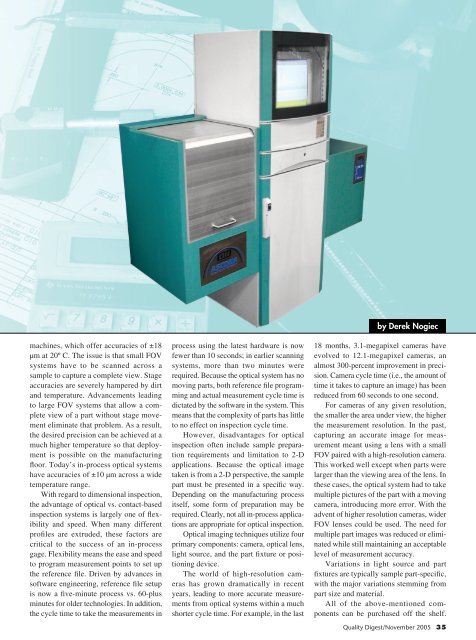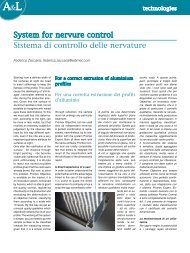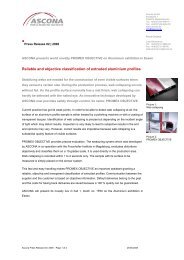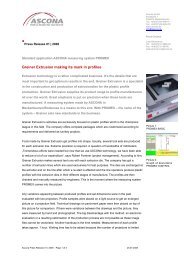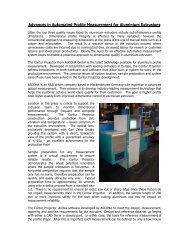The Case for In-Process Gaging - ASCONA
The Case for In-Process Gaging - ASCONA
The Case for In-Process Gaging - ASCONA
Create successful ePaper yourself
Turn your PDF publications into a flip-book with our unique Google optimized e-Paper software.
machines, which offer accuracies of ±18<br />
µm at 20º C. <strong>The</strong> issue is that small FOV<br />
systems have to be scanned across a<br />
sample to capture a complete view. Stage<br />
accuracies are severely hampered by dirt<br />
and temperature. Advancements leading<br />
to large FOV systems that allow a complete<br />
view of a part without stage movement<br />
eliminate that problem. As a result,<br />
the desired precision can be achieved at a<br />
much higher temperature so that deployment<br />
is possible on the manufacturing<br />
floor. Today’s in-process optical systems<br />
have accuracies of ±10 µm across a wide<br />
temperature range.<br />
With regard to dimensional inspection,<br />
the advantage of optical vs. contact-based<br />
inspection systems is largely one of flexibility<br />
and speed. When many different<br />
profiles are extruded, these factors are<br />
critical to the success of an in-process<br />
gage. Flexibility means the ease and speed<br />
to program measurement points to set up<br />
the reference file. Driven by advances in<br />
software engineering, reference file setup<br />
is now a five-minute process vs. 60-plus<br />
minutes <strong>for</strong> older technologies. <strong>In</strong> addition,<br />
the cycle time to take the measurements in<br />
process using the latest hardware is now<br />
fewer than 10 seconds; in earlier scanning<br />
systems, more than two minutes were<br />
required. Because the optical system has no<br />
moving parts, both reference file programming<br />
and actual measurement cycle time is<br />
dictated by the software in the system. This<br />
means that the complexity of parts has little<br />
to no effect on inspection cycle time.<br />
However, disadvantages <strong>for</strong> optical<br />
inspection often include sample preparation<br />
requirements and limitation to 2-D<br />
applications. Because the optical image<br />
taken is from a 2-D perspective, the sample<br />
part must be presented in a specific way.<br />
Depending on the manufacturing process<br />
itself, some <strong>for</strong>m of preparation may be<br />
required. Clearly, not all in-process applications<br />
are appropriate <strong>for</strong> optical inspection.<br />
Optical imaging techniques utilize four<br />
primary components: camera, optical lens,<br />
light source, and the part fixture or positioning<br />
device.<br />
<strong>The</strong> world of high-resolution cameras<br />
has grown dramatically in recent<br />
years, leading to more accurate measurements<br />
from optical systems within a much<br />
shorter cycle time. For example, in the last<br />
by Derek Nogiec<br />
18 months, 3.1-megapixel cameras have<br />
evolved to 12.1-megapixel cameras, an<br />
almost 300-percent improvement in precision.<br />
Camera cycle time (i.e., the amount of<br />
time it takes to capture an image) has been<br />
reduced from 60 seconds to one second.<br />
For cameras of any given resolution,<br />
the smaller the area under view, the higher<br />
the measurement resolution. <strong>In</strong> the past,<br />
capturing an accurate image <strong>for</strong> measurement<br />
meant using a lens with a small<br />
FOV paired with a high-resolution camera.<br />
This worked well except when parts were<br />
larger than the viewing area of the lens. <strong>In</strong><br />
these cases, the optical system had to take<br />
multiple pictures of the part with a moving<br />
camera, introducing more error. With the<br />
advent of higher resolution cameras, wider<br />
FOV lenses could be used. <strong>The</strong> need <strong>for</strong><br />
multiple part images was reduced or eliminated<br />
while still maintaining an acceptable<br />
level of measurement accuracy.<br />
Variations in light source and part<br />
fixtures are typically sample part-specific,<br />
with the major variations stemming from<br />
part size and material.<br />
All of the above-mentioned components<br />
can be purchased off the shelf.<br />
Quality Digest/November 2005 35


